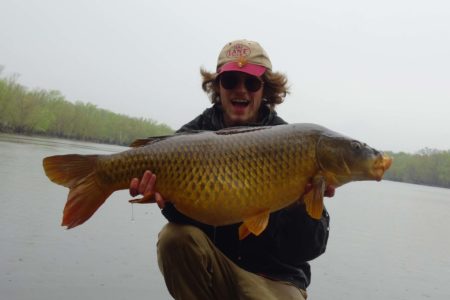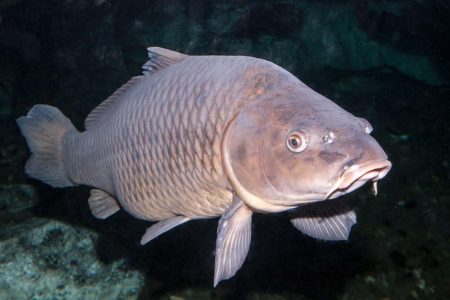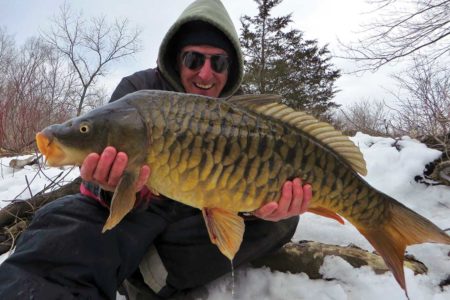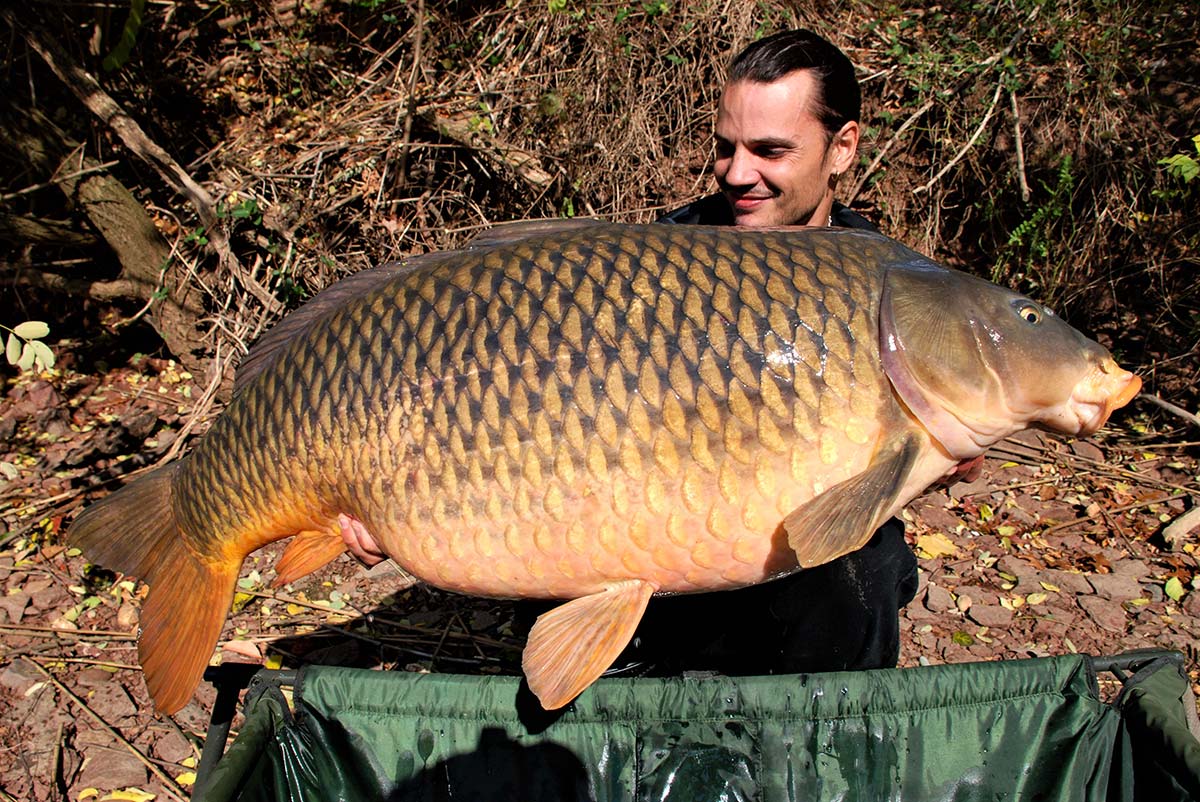
European methods of fishing proven to work on Long Island.
Some American anglers might consider carp to be nothing more than oversized members of the minnow family and a fish not worthy of their attention. And some might also be inclined to mistakenly use the term “trash fish.” But to anyone who has hooked and fought carp, especially those specimens over 20 pounds, there is nothing unworthy about them. European anglers have long known that and are well aware of the sporting qualities of carp. To them, carp are a revered species of fish, and they are as zealous about carp as are American freshwater bass anglers. And over the past decade or so, many U.S. anglers have also come to appreciate carp’s unique habits and challenging behaviors. It is indeed a contradiction to refer to carp as simply gigantic minnows, for they are a species with diverse angling potential. A segment of lower-48 anglers have discovered that aspect of carp fishing and has begun to embrace the species as a formidable adversary. This is especially true of the light tackle and fly-fishing crowds who sight-fish carp as one would when fishing the flats for bonefish, permit, or striped bass. But traditional bait techniques are still very much preferred for exceptionally large carp because of the effectiveness and consistency of those methods.
A Carp Epiphany
My impressions of carp fishing radically changed several years back when I encountered a dedicated and passionate carp fisherman at a local pond where I often fish. At first, I was intrigued by the gear this angler was employing. What caught my immediate attention were the sizeable meatball-shaped bait globs he was lobbing like depth charges out into the middle of the pond. Secondly, he had a trio of surf-length technical rods set up in a tripod-type holder, with electronic strike indicators attached to reveal the slightest take with an urgent beeping sound. Approaching him, I learned his name, Raphael Biagini. Subsequently, I discovered Raphael was one of the most accomplished trophy carp anglers in France and throughout Europe. Raphael now calls the United States home and applies his Euro-carp fishing techniques to many newly-discovered lakes, ponds, and rivers, especially those in the Northeast. His reputation rapidly grows in the U.S. as a master angler of monster carp. To give a sense of the magnitude of Raphael’s achievements, these are a few of his most significant carp fishing accomplishments: largest mirror carp, 78.2 pounds; largest common carp, 64.8 pounds; largest American carp, 54.8 pounds; and his largest Koi, 30 pounds. Regardless of where Raphael casts a carp bait, the money line is in his favor for finding, luring, and catching some of the largest carp that swim in those waters. And to my amazement, I learned that from this small local pond, where I have caught moderate to large carp, Raphael caught and released giant fish of between 45 and 50 pounds. His applied skills and knowledge know no boundaries. With results like those, I desired to understand more about Raphael’s methods, tactics, and philosophy of carp fishing.
Fundamentally, Raphael is an advocate and practitioner of European-style carp fishing. He pursues carp with a 360-degree perspective that, first and foremost, involves in-depth observation of the waters he selects to fish. While in Europe, Raphael would target the best-known carp waters, but here in the U.S., he has embarked upon a journey of discovery to seek out quality waters. Raphael says, “Carp fishing in the U.S. is not as popular as it is in Europe, and almost everything needs to be discovered. I still try my best to target the biggest fish, but it requires a lot of effort as there is a lot of water and a lot of small fish.” Small is a relative term, for many of Raphael’s smaller carp would be other anglers’ trophy fish. Regarding Raphael’s many accomplishments, it is evident that he has been very successful on two counts: finding new quality waters and huge U.S. carp.
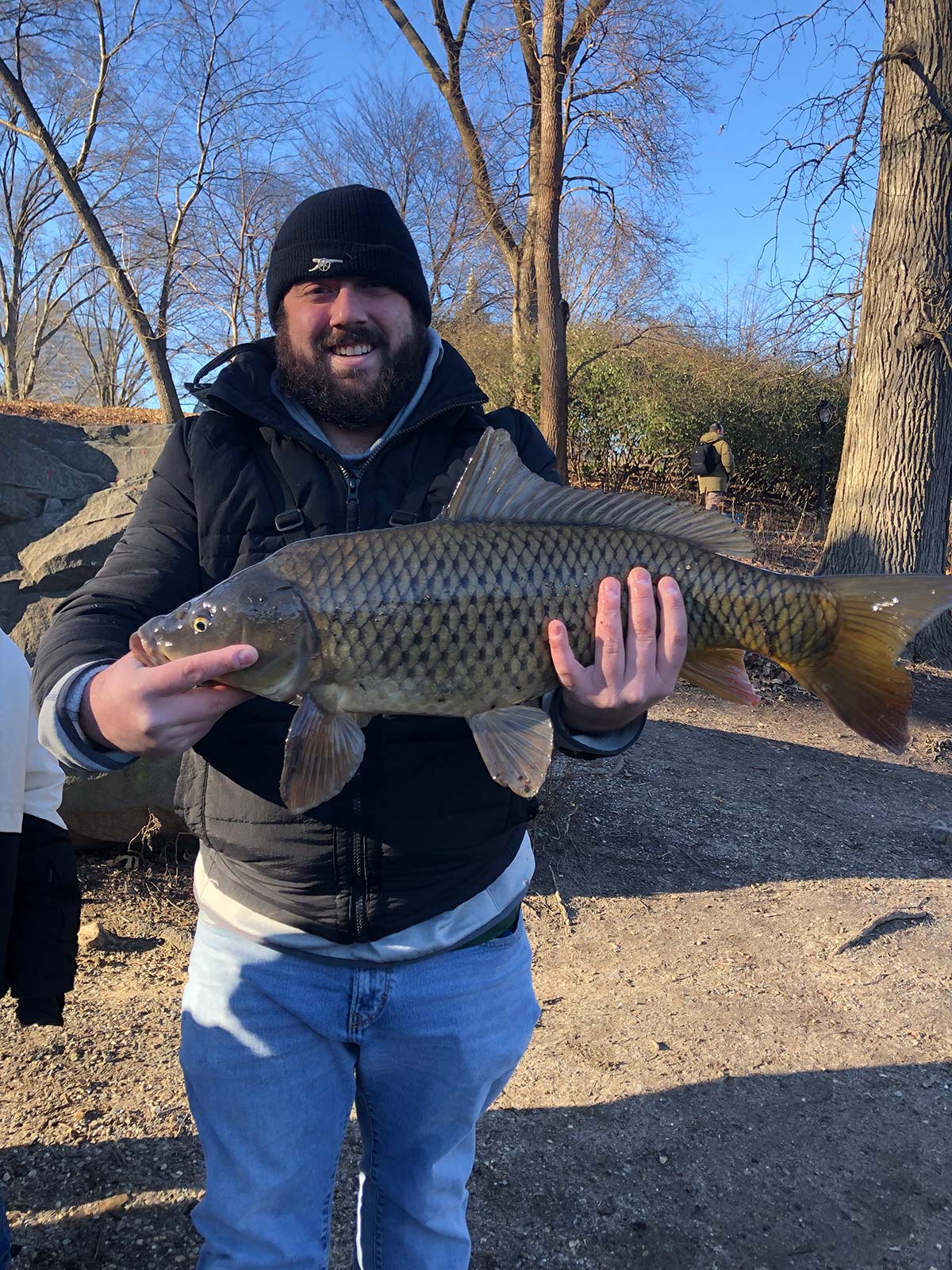
What Is Euro-Style Carp Fishing?
Like freshwater bass fishing in the U.S., European carp fishing is much more than a sport or pastime. It is, for many, a way of life that revolves around an obsession with a fish. Carp are worshiped in Europe, and fishing for them is as much a tradition as it is a passion. It is generally acknowledged that the modern era of European carp fishing began in the 1950s in the United Kingdom and then spread rapidly throughout other countries. Carp were brought to the United States in the 19th century and were then harvested primarily by Europeans who had fished for them in their native countries before emigrating to the U.S.
Many American anglers initially found carp distasteful, and it took decades for carp to gain some semblance of respect in this country. It wasn’t until contemporary U.S. anglers began to fish for carp with light tackle and fly gear that they also began to appreciate the sporting qualities of the species. Yet, the fact remains that many of the carp taken with those angling methods are often small to medium-sized fish. Most trophy fish are still caught with bait and European techniques. While American anglers will typically employ baits like kernel corn, bread, dough balls, and some packaged baits, European anglers prefer prepared baits like boilies, which are rolled, circular baits briefly boiled in water to create a durable outer layer. Boilies are both an attractor bait as well as a source of food. Bright colors and scented ingredients add to the appeal of these baits. From empirical and anecdotal evidence, the use of boilies has resulted in larger average-size carp being caught than other forms of bait. Ground baits, pop-up baits, and hook baits are also popular. This diversity of baits allows the carp angler to fish the entire water column, depending on the specific behaviors of the carp. Raphael considers boilies his favorite bait, followed by various particle baits like corn, barley, beans, and chufa. He will sometimes use some form of ground bait to enhance the appeal of his chumming.
Another trademark of European carp fishing is the use of long rods, about 12 feet in length. The rods are set into a tripod-style holder that typically accommodates three rods. The rods are matched to surf fishing-size reels. The reason for those specific set-ups is that shorebound anglers often need long casts to reach areas where carp are holding and feeding. Carp are a species that readily make their presence known to anglers. They can jump from the water, cruise near the surface, or ‘mud’ like redfish or bonefish when bottom feeding. And carp will often hold in groups in shallow water. European anglers will also use bite indicators that signal the slightest take when a carp eats the bait. This gives the angler ample time to watch the carp swim off with the bait and to set the hook appropriately. Traditional European fishing for carp involves bait and a ‘sit and wait’ technique.
The fished area will often be seeded with some form of pre-bait like ground and scented meal. This form of chumming will typically be done either a day or more before the actual fishing begins. This tactic aims to attract the carp to a specific area where they get conditioned to feed. This increases their receptivity to eat hooked bait. Anglers will frequently fish around a 72-hour window once chumming has taken place and through a period of intense feeding activity, brought about by the pre-baiting. And in Europe, a carp fishing session might extend for days at a time. It is easy to see how this form of fishing can become a lifestyle rather than simply a pastime. Anglers who fish for carp in this manner are very conservation-minded and work to release carp in a way that minimizes mortality. To that end, those anglers use cradle-style nets to land large carp before release. This method of landing a super-size carp limits the stress on the fish’s internal organs and helps to avoid any injuries.
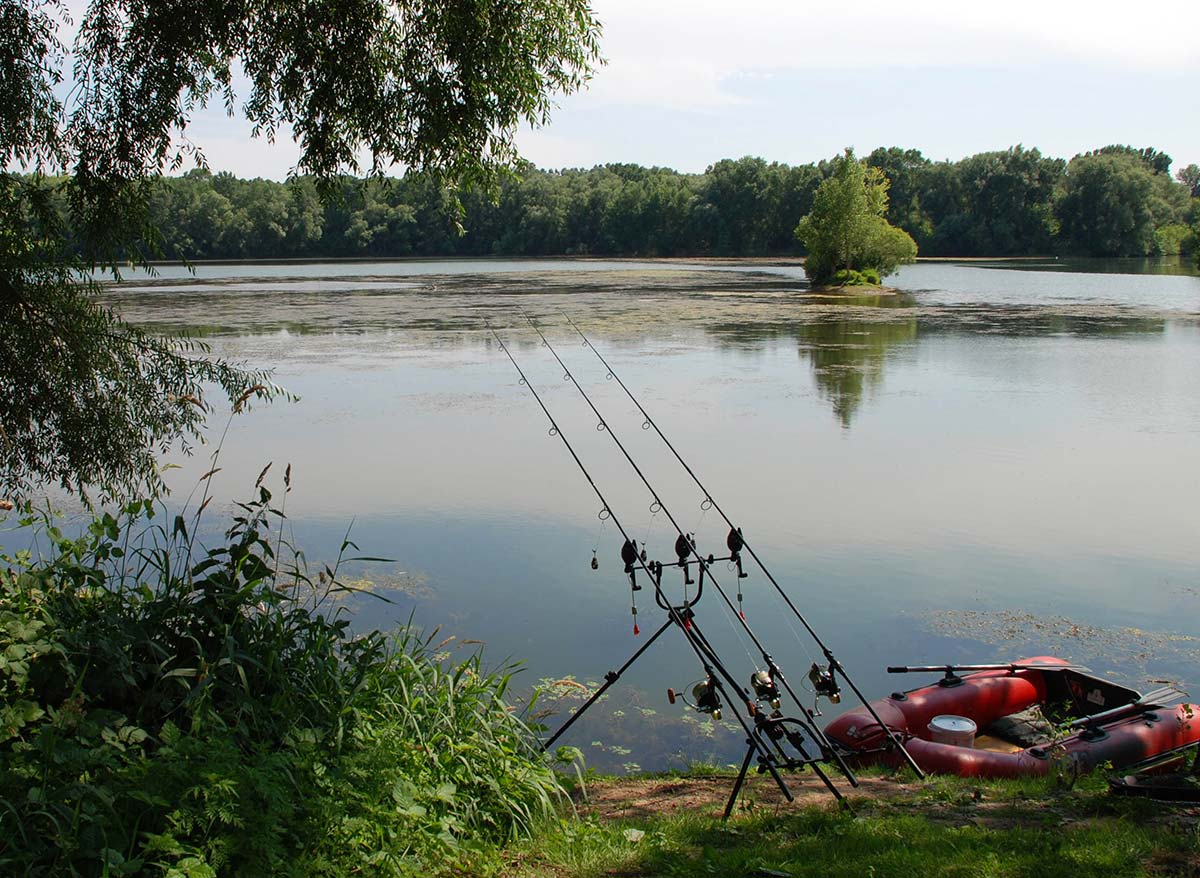
Carp Physiology And Habits
Carp are omnipresent and can be found in most lakes, ponds, slow-moving rivers, and meandering streams like many such waters found in the Northeast. Carp are transplants from Asia, and although not native to North America, they have established strongholds and thrive in many waters. The common carp is the king of the hill in the minnow family, representing one of the largest species of that clan. Mirror carp are also very abundant. Carp, as a species, are adaptive, resilient, intelligent, wary, and can live a long time, with some documented specimens over 65 years of age and weighing over 90 pounds. Anglers in the Northeast can expect to encounter common carp within a range of approximately 4 pounds to 30 pounds.
Carp rely on all their senses to survive and feed, and this aspect of their physiology is of utmost importance to anglers. Their fleshy mouths are designed for bottom feeding and rooting among the muck and vegetation. Barbels on each side of the mouth aid carp with their senses of taste and feel. While common carp utilize all senses when feeding, smell, and taste are paramount. Carp can make quick decisions about whether or not a potential food item is edible. What a carp cannot see is often detected by its barbels. The orientation of a carp’s eyes is of particular importance, creating a blind spot in front of and below the snout. While the window of placement is small, a bait dropped softly ahead of the area of impaired vision will be sensed by the barbels. A bait gently placed ahead of a carp’s path will, in most instances, be met with interest, although not all encounters result in strikes and hook-ups. Carp refuse more of their intake than they ingest, and they can do so with lightning speed. Carp can spit out a non-appealing bait faster than one can blink the eyes.
Carp are omnivorous feeders. Their food sources span aquatic plants to worms, insects, and crustaceans. Carp feeding behavior is often dictated by the specific water they live in. In large impoundments, rivers, and streams where the fish feed totally on natural food, they are very receptive to baits like boilies, dough balls, and kernel corn. At the opposite end of the spectrum are the duck ponds where carp also thrive. In these ponds, carp feeding behaviors are very much affected by human intervention. People like to feed waterfowl, and it doesn’t take long for carp in that environment to become conditioned to the artificially-induced food source. You will often see carp become very active as ducks are being fed. The fish will gather in numbers under the waterfowl and pick off pieces of bread, corn, or other feed that escape the frenzied ducks.
As with many fish species, carp will feed more aggressively and with less vigilance as the water cools in late fall and early winter. To some extent, they throw a bit of caution to changing winds and cooling water temperatures. In shallow ponds and backwaters off the main channel of rivers and during periods of high sun, you can easily spot carp as dark, elongated shapes either at rest or as slow-moving “logs.” Carp are as wary, if not more so, than trout. Carp can be easily spooked by anything that appears unnatural to their environment, and they will bolt at the simplest of mistakes. Raphael’s approach to patterning the behaviors of carp is very much akin to how a whitetail deer hunter scouts the movements of a big buck: discover where they feed, where they bed or hold, and the migration path to and from those locations.
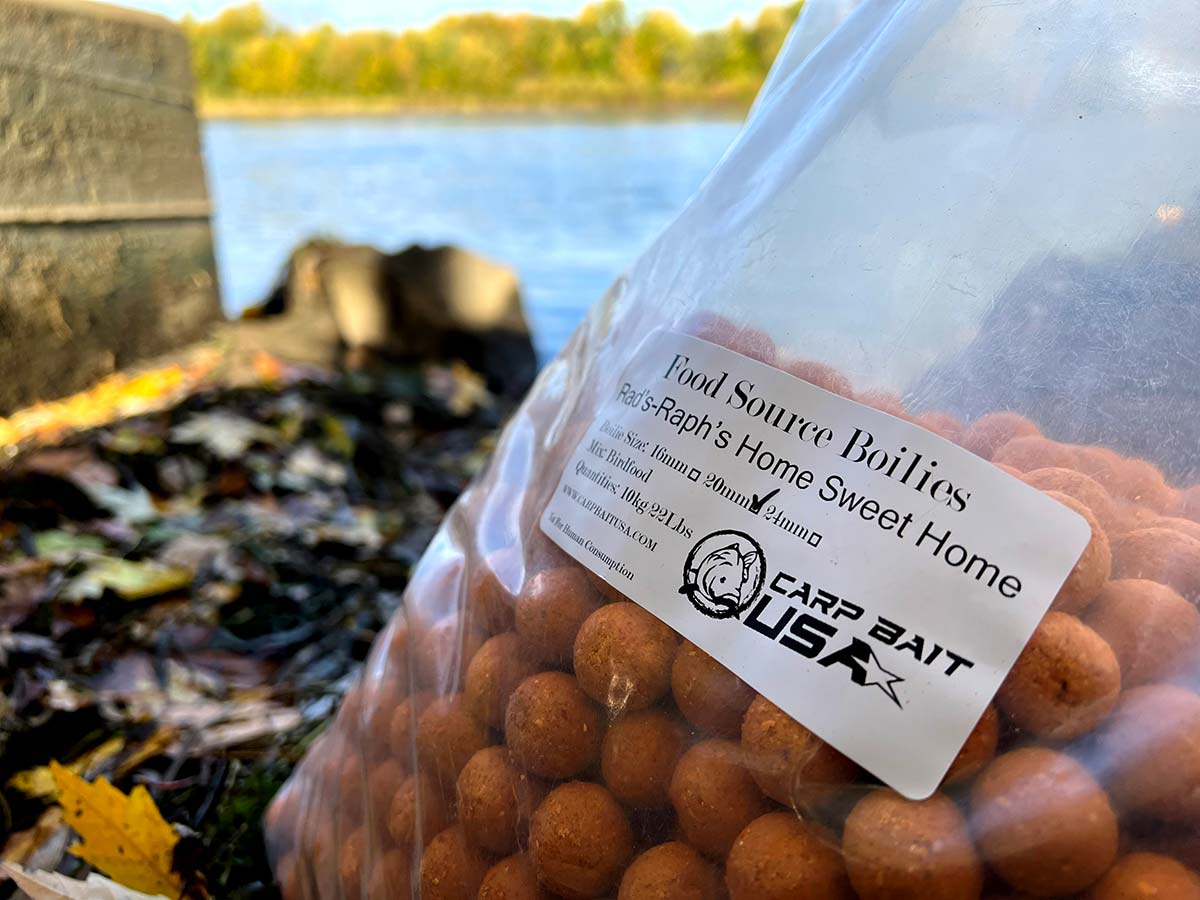
HI IQ
Carp are smart creatures, and they learn from experience. They have the ability to recall positive and negative events, put the pieces together, and react accordingly. I have encountered a number of small pond situations where carp would aggressively take the bait on one trip, and then on subsequent outings to the same area, totally reject those same offerings. Being able to watch their behaviors, I noticed the refusals were so emphatic it seemed the carp knew the deceptive bait represented danger. Could it have been a fish that had been previously caught, or did that fish’s pack mates learn from the negative experiences of other fish? I suspect both since this has happened more than one would simply associate with coincidence.
A Most Challenging Species
When discussing carp behavior with Raphael, he offered that successful anglers never forget that carp, like all other living creatures, are motivated to “Survive, eat and reproduce” and that anglers should always observe carp behaviors, remain confident in their approach, and stay committed to a strategy.
| SENSE MASTERS |
| Carp have an excellent sense of “hearing” and pounding boots along the bank will also send them scurrying, leaving you to stare in disappointment at their massive wakes. When that happens it is best to move on and return only after the area has been thoroughly rested. Very often those same fish will return after they calm down. Carp also have good eyesight. Their cone of vision is such that when approached closely enough to their shoreline lairs they can see you as well as you can see them. An angler’s movements should be slow and deliberate to avoid detection. It also helps to wear drab or camouflage clothing. |
To increase one’s odds of a connection, areas of high fish density and activity should be targeted. The angler should also take a micro view of the water and pay close attention to near-shore areas where carp might rest, especially shallow areas or slow-moving eddies and sloughs. Little else is as frustrating when pursuing pond carp as walking up to the shore only to spook a pod of big fish at the water’s edge. Once those carp scatter, you can forget about catching them on that outing. And much like bonefish, when they flee, they will take other carp with them, often clearing out an entire area that was moments before alive with fish. To minimize this, the wise carp angler must approach those areas cautiously. For example, when you happen upon fish milling about within range, watch their behaviors first before casting. Even when fishing with bait, wait to see if they bury their snouts into the bottom muck and begin to root for food. Large groups of carp have too many senses at work simultaneously for the angler to avoid detection.
Carp are finicky, wary, and sometimes discriminating feeders, providing challenging fishing experiences. Like most species of fish, those huge carp tend to be loners or travel with other fish their size. Give Euro carping a try, and get one of these freshwater cows to eat your bait. You will be hooked as the fish.
